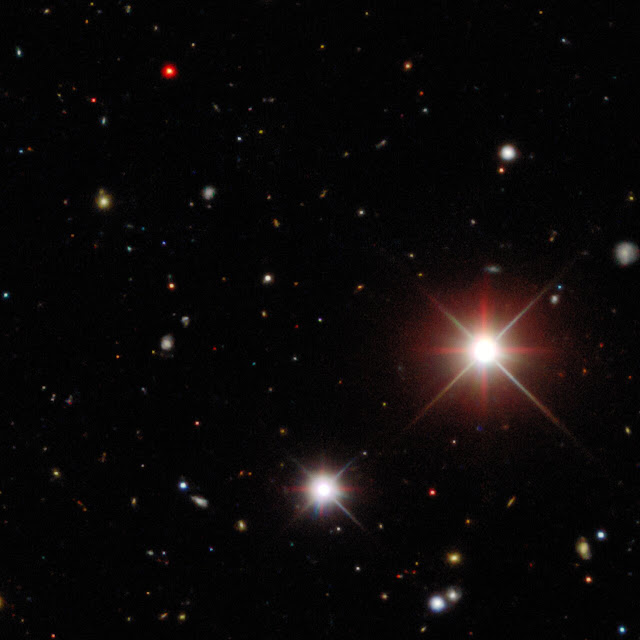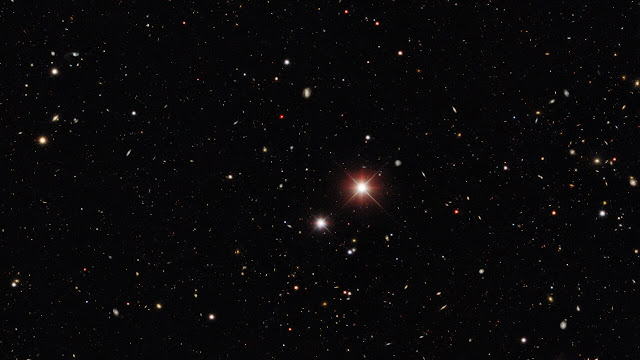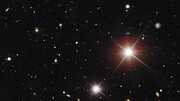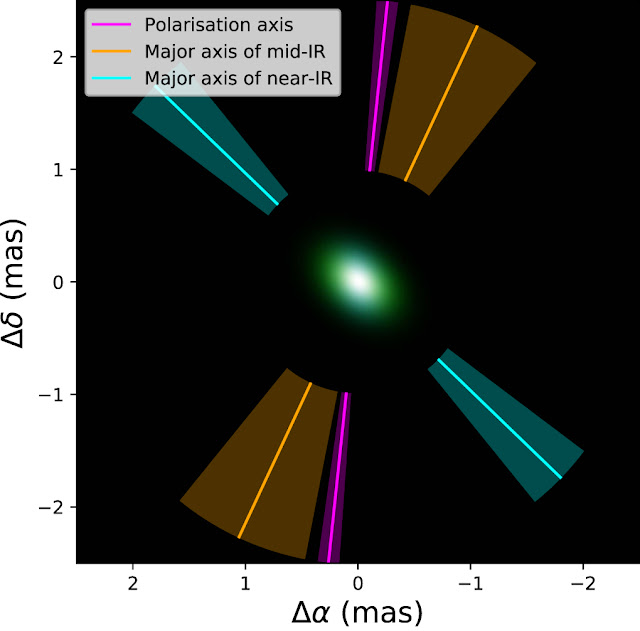Illustration of Comet Bernardinelli-Bernstein
Discovery image of Comet Bernardinelli-Bernstein (annotated)
Discovery image of Comet Bernardinelli-Bernstein (unannotated)
Discovery image of Comet Bernardinelli-Bernstein (wide field)
Videos
Zooming on Comet Bernardinelli-Bernstein Videos
Estimated to be 100–200 kilometers across, the unusual wandering body will make its closest approach to the Sun in 2031 A giant comet from the outskirts of our
Solar System has been discovered in 6 years of data from the Dark Energy
Survey. Comet Bernardinelli-Bernstein is estimated to be about 1000
times more massive than a typical comet, making it arguably the largest
comet discovered in modern times. It has an extremely elongated orbit,
journeying inward from the distant Oort Cloud over millions of years. It
is the most distant comet to be discovered on its incoming path, giving
us years to watch it evolve as it approaches the Sun, though it's not
predicted to become a naked-eye spectacle.
A giant comet has been discovered by two astronomers following a comprehensive search of data from Dark Energy Survey (DES).
The comet, which is estimated to be 100–200 kilometers across, or about
10 times the diameter of most comets, is an icy relic flung out of the
Solar System by the migrating giant planets in the early history of the
Solar System. This comet is quite unlike any other seen before and the
huge size estimate is based on how much sunlight it reflects.
Pedro Bernardinelli and Gary Bernstein, of the University of Pennsylvania, found the comet — named Comet Bernardinelli-Bernstein (with the designation C/2014 UN271) — hidden among data collected by the 570-megapixel Dark Energy Camera (DECam) mounted on the Víctor M. Blanco 4-meter Telescope at Cerro Tololo Inter-American Observatory (CTIO) in Chile. The analysis of data from the Dark Energy Survey is supported by the Department of Energy (DOE) and the National Science Foundation (NSF), and the DECam science archive is curated by the Community Science and Data Center (CSDC) at NSF’s NOIRLab. CTIO and CSDC are Programs of NOIRLab.
One of the highest-performance, wide-field CCD imagers in the world,
DECam was designed specifically for the DES and operated by the DOE and
NSF between 2013 and 2019. DECam was funded by the DOE and was built and
tested at DOE's Fermilab. At present DECam is used for programs covering a huge range of science.
DES was tasked with mapping 300 million galaxies across a
5000-square-degree area of the night sky, but during its six years of
observations it also observed many comets and trans-Neptunian objects
passing through the surveyed field. A trans-Neptunian object, or TNO,
is an icy body that resides in our Solar System beyond the orbit of
Neptune.
Bernardinelli and Bernstein used 15–20 million CPU hours at the National Center for Supercomputing Applications
and Fermilab, employing sophisticated identification and tracking
algorithms to identify over 800 individual TNOs from among the more than
16 billion individual sources detected in 80,000 exposures taken as
part of the DES. Thirty-two of those detections belonged to one object
in particular — C/2014 UN271.
Comets are icy bodies that evaporate as they approach the warmth of the Sun, growing their coma
and tails. The DES images of the object in 2014–2018 did not show a
typical comet tail, but within a day of the announcement of its
discovery via the Minor Planet Center, astronomers using the Las Cumbres Observatory
network took fresh images of Comet Bernardinelli-Bernstein which
revealed that it has grown a coma in the past 3 years, making it
officially a comet.
Its current inward journey began at a distance of over 40,000
astronomical units (au) from the Sun — in other words 40,000 times
farther from the Sun than Earth is, or 6 trillion kilometers away (3.7
trillion miles or 0.6 light-years — 1/7 of the distance to the nearest
star). For comparison, Pluto is 39 au from the Sun, on average. This
means that Comet Bernardinelli-Bernstein originated in the Oort Cloud
of objects, ejected during early history of the Solar System. It could
be the largest member of the Oort Cloud ever detected, and it is the
first comet on an incoming path to be detected so far away.
Comet Bernardinelli-Bernstein is currently much closer to the Sun. It
was first seen by DES in 2014 at a distance of 29 au (4 billion
kilometers or 2.5 billion miles, roughly the distance of Neptune), and
as of June 2021, it was 20 au (3 billion kilometers or 1.8 billion
miles, the distance of Uranus) from the Sun and currently shines at
magnitude 20. The comet's orbit is perpendicular to the plane of the
Solar System and it will reach its closest point to the Sun (known as perihelion)
in 2031, when it will be around 11 au away (a bit more than Saturn’s
distance from the Sun) — but it will get no closer. Despite the comet’s
size, it is currently predicted that skywatchers will require a large
amateur telescope to see it, even at its brightest.
"We have the privilege of having discovered perhaps the largest
comet ever seen — or at least larger than any well-studied one — and
caught it early enough for people to watch it evolve as it approaches
and warms up," said Gary Bernstein. "It has not visited the Solar System in more than 3 million years."
Comet Bernardinelli-Bernstein will be followed intensively by the
astronomical community, including with NOIRLab facilities, to understand
the composition and origin of this massive relic from the birth of our
own planet. Astronomers suspect that there may be many more undiscovered
comets of this size waiting in the Oort Cloud far beyond Pluto and the
Kuiper Belt. These giant comets are thought to have been scattered to
the far reaches of the Solar System by the migration of Jupiter, Saturn, Uranus and Neptune early in their history.
“This is a much needed anchor on the unknown population of large
objects in the Oort Cloud and their connection with early migration of
the ice/gas giants soon after the Solar System was formed,” said NOIRLab astronomer Tod Lauer.
“These observations demonstrate the value of long-duration survey observations on national facilities like the Blanco telescope,” says Chris Davis, National Science Foundation Program Director for NOIRLab. “Finding
huge objects like Comet Bernardinelli-Bernstein is crucial to our
understanding of the early history of our Solar System.”
It is not yet known how active and bright it will become when it reaches perihelion. However, Bernardinelli says that Vera C. Rubin Observatory, a future Program of NOIRLab, “will
continuously measure Comet Bernardinelli-Bernstein all the way to its
perihelion in 2031, and probably find many, many others like it,” allowing astronomers to characterize objects from the Oort Cloud in much greater detail.
More InformationThis research was reported to the Minor Planet Center.
NSF’s NOIRLab (National
Optical-Infrared Astronomy Research Laboratory), the US center for
ground-based optical-infrared astronomy, operates the international Gemini Observatory (a facility of NSF, NRC–Canada, ANID–Chile, MCTIC–Brazil, MINCyT–Argentina, and KASI–Republic of Korea), Kitt Peak National Observatory (KPNO), Cerro Tololo Inter-American Observatory (CTIO), the Community Science and Data Center (CSDC), and Vera C. Rubin Observatory (operated in cooperation with the Department of Energy’s SLAC National Accelerator Laboratory). It is managed by the Association of Universities for Research in Astronomy (AURA)
under a cooperative agreement with NSF and is headquartered in Tucson,
Arizona. The astronomical community is honored to have the opportunity
to conduct astronomical research on Iolkam Du’ag (Kitt Peak) in Arizona,
on Maunakea in Hawai‘i, and on Cerro Tololo and Cerro Pachón in Chile.
We recognize and acknowledge the very significant cultural role and
reverence that these sites have to the Tohono O'odham Nation, to the
Native Hawaiian community, and to the local communities in Chile,
respectively.
The Dark Energy Survey (DES)
is a collaboration of more than 400 scientists from 25 institutions in
seven countries. Funding for the DES Projects has been provided by the
US Department of Energy Office of Science, US National Science
Foundation, Ministry of Science and Education of Spain, Science and
Technology Facilities Council of the United Kingdom, Higher Education
Funding Council for England, ETH Zurich for Switzerland, National Center
for Supercomputing Applications at the University of Illinois at
Urbana-Champaign, Kavli Institute of Cosmological Physics at the
University of Chicago, Center for Cosmology and AstroParticle Physics at
Ohio State University, Mitchell Institute for Fundamental Physics and
Astronomy at Texas A&M University, Financiadora de Estudos e
Projetos, Fundação Carlos Chagas Filho de Amparo à Pesquisa do Estado do
Rio de Janeiro, Conselho Nacional de Desenvolvimento Científico e
Tecnológico and Ministério da Ciência e Tecnologia, Deutsche
Forschungsgemeinschaft, and the collaborating institutions in the Dark Energy Survey.
NCSA at the University of Illinois at Urbana-Champaign
provides supercomputing and advanced digital resources for the nation’s
science enterprise. At NCSA, University of Illinois faculty, staff,
students and collaborators from around the globe use advanced digital
resources to address research grand challenges for the benefit of
science and society. NCSA has been advancing one third of the Fortune
50® for more than 30 years by bringing industry, researchers and
students together to solve grand challenges at rapid speed and scale.
For more information.
Fermilab is America’s premier
national laboratory for particle physics and accelerator research. A US
Department of Energy Office of Science laboratory, Fermilab is located
near Chicago, Illinois, and operated under contract by the Fermi
Research Alliance LLC. Follow Fermilab on Twitter at @Fermilab.
The DOE Office of Science is
the single largest supporter of basic research in the physical sciences
in the United States and is working to address some of the most
pressing challenges of our time.
Bernardinelli and Bernstein’s search was partially supported by a grant from the National Science Foundation.
Links
Contacts
Pedro Bernardinelli
University of Pennsylvania
Email: pedrobe@sas.upenn.edu
Gary Bernstein
University of Pennsylvania
Email: garyb@physics.upenn.edu
Amanda Kocz
Press and Internal Communications Officer
NSF’s NOIRLab
Cell: +1 626 524 5884
Email: amanda.kocz@noirlab.edu
Source: NOIRLab/News























